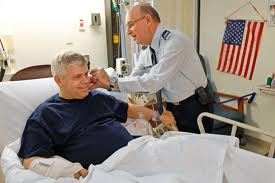Auricular therapy around the world
Needle-based acupuncture has been practiced in Asia for thousands of years, but only a few specific points were used on the ear; not as an entire acupuncture system. In November of 1997, a consensus panel of the U.S National Institutes of Health (NIH) gave conditional approval of the practice of acupuncture. They included an evaluation of those studies that supported the use of ear acupuncture for pain relief and addiction treatment (quitting smoking, drugs, alcohol).
Auricular therapy has been used in continental Europe for the past 40 years. The body of international research supporting it is quite impressive. Research studies in China and the USA verified the scientific accuracy of auricular diagnosis:
In China the ear points of over 2,000 patients were assessed recording which points correlated with certain diseases and which ear points lead to reduction of medical symptoms.
At UCLA 75% accuracy was achieved in correctly diagnosing the location of the musculoskeletal pain problems of 40 patients. Expert panels were formed by the World Health Organization leading to international standardization of identification of ear reflex points.
Auricular acupuncture has even been used to treat pain for cancer patients when prescription medicine was ineffective. A research study involving 90 cancer patients was published in the Journal of Clinical Oncology (Vol 21, Issue 22 (November), 2003: 4120-4126). The scientists concluded that there was a clear benefit from auricular treatment for cancer related pain.
Soldier's attention

Auricular therapy was successfully implemented into the United States Armed Forces thanks to recently retired Air Force Colonel Richard C. Niemtzow, M.D., Ph.D., M.P.H. He is a radiation oncologist, who became the first full-time physician acupuncturist for the U.S. Armed Forces. Dr. Niemtzow teaches military physicians an auricular technique called “Battlefield Acupuncture.” He established an extremely popular clinic at Andrews Air Force Base, where he serves personnel from Andrews, the Pentagon, White House, National Naval Medical Center, and Walter Reed Army Medical Center. Dr. Niemtzow is currently (2015) Consultant for Alternative Medicine for the United States Air Force Surgeon General. He also represents the Department of Defense at the National Institutes of Health, National Center for Complementary and Alternative Medicine Advisory Council.
Paul Nogier, M.D.

The Chinese were quite brilliant in their developments of acupuncture. However, they did not know that the ear could serve as an entire system of acupuncture. The development of the science of auricular therapy is credited to Paul Nogier, M.D. (1908-1996). He was a conventionally-trained neurologist, who also had an engineering background. He taught at the medical school in Lyon, France.
During the 1950s, Dr. Nogier noticed a strange scar on the upper ear of some of his patients. The doctor learned these marks were created by a woman from Marseille named Madame Barrin. Although she was not a doctor, she somehow learned how to intentionally burn (cauterize) a specific area on the outer ear in order to relieve their low back and thigh pain (sciatica). She had no idea why or how it worked. Amazed and fascinated by this unheard of procedure, Dr. Nogier observed it, and performed the same procedure on his own sciatica patients with some success.
With side effects of drugs being a concern, Dr. Nogier sought methods of treatment that worked on a physical and energetic plane, rather than chemical. Thus, the professor studied homeopathic medicine, manual spinal correction, and acupuncture. He reasoned that needling the ear rather than burning it might be a much gentler, less drastic, yet equally effective approach.
Eventually, Dr. Nogier determined that this “magical” sciatica spot was a reflex point that corresponded directly with the fifth lumbar vertebra and its neighboring sacroiliac joint. This is where the sciatic nerve exits the spine, and runs down the leg. Despite the lack of scientific validation, Nogier persisted with detailed investigation of this phenomenon. He keenly hypothesized that if this spot on the ear was effective in treating low back pain, maybe other parts of the ear could treat other parts of the body too. Through extensive experimentation, Dr. Nogier systematically mapped out energetic ear reflex projection zones for the entire body.
In a fascinating development, he observed that the pattern could be compared to an upside-down human fetus.
The head projects electrical changes to lower ear lobe, the feet at the top of the ear, and the rest of the body in-between. This model was first presented in France in 1957, then spread to Germany, and finally was translated into Chinese. In 1958 the Chinese embraced and adopted this model of acupuncture that was previously unknown to them despite thousands of years of acupuncture practice. They acknowledged Dr. Paul Nogier as the “Father of Auricular Therapy.” Not satisfied with these initial extraordinary findings, he continued research for decades. Nogier understood that the human body functions through always-changing and highly dynamic systems.
Several years later, Dr. Nogier and his research team determined this remarkable "inverted fetus" presentation to be merely one of three possible energy projection patterns that reflected problems in the body. They discovered that the surface of the ear is actually a 3-dimensional, holographic energetic projector of the human anatomy and physiology. A hologram is a 3-dimensional image of an object, which contains the information of the object itself… and in every part of itself. Dennis Gabor theorized the concept of holography in 1947. Leith and Upatniecks introduced it practically by 1964.
Every part of the body has three distinct areas for which electrical changes could develop. These are called auricular energy phases. Which zone develops electrical changes depends upon nature of the problem. A sudden or acute condition causes changes in a pinpoint area of one particular zone. A chronic problem results in electrical activity in another zone, quite a distance away. Any physical changes, tissue damage, injury, or degeneration leads to electrically detectable ear acupuncture points in yet another distinct area. There isn't just one zone or point on the ear for each organ or tissue; there are three different areas to consider and Dr. Paul Nogier's research revealed seven specific frequencies that must be used for different areas of the ear for electrical treatment. Strict attention to proper frequencies greatly enhances results.
Despite its success, most North American doctors are unfamiliar with it. Auricular therapy has proven to bring pain relief and support healing, in many cases, after all other medical interventions have failed. Doctors and anybody in the lay public, who don't "believe in" auricular therapy must realize that it is not an unproven or mystical treatment approach. We would encourage Physicians to read the vast array of published medical research on the subject of auricular therapy, and acupuncture in general for a better understanding of how they can expand to aid their patients. In the scheme of history, acupuncture has been safely and effectively used long before the first pharmaceutical drug was patented and sold. The science of auricular therapy has been well documented, internationally researched, with over 800 papers published in peer-reviewed medical journals. It is not only taught in France, but all of Europe—especially Germany. It is practiced by several thousand European medical doctors.
The WHO lists 150 conditions for which Auricular therapy is appropriate. Examples include various neurological and orthopedic disorders such as: headaches, migraines, trigeminal neuralgia, facial paralysis, peripheral neuropathy, meniere’s disease, intercostal neuralgia, tennis elbow, sciatica, lumbar pain, rheumatoid arthritis, cancer pain, dry mouth, hot flashes, etc. It has also been successful in helping people with chronic allergies
